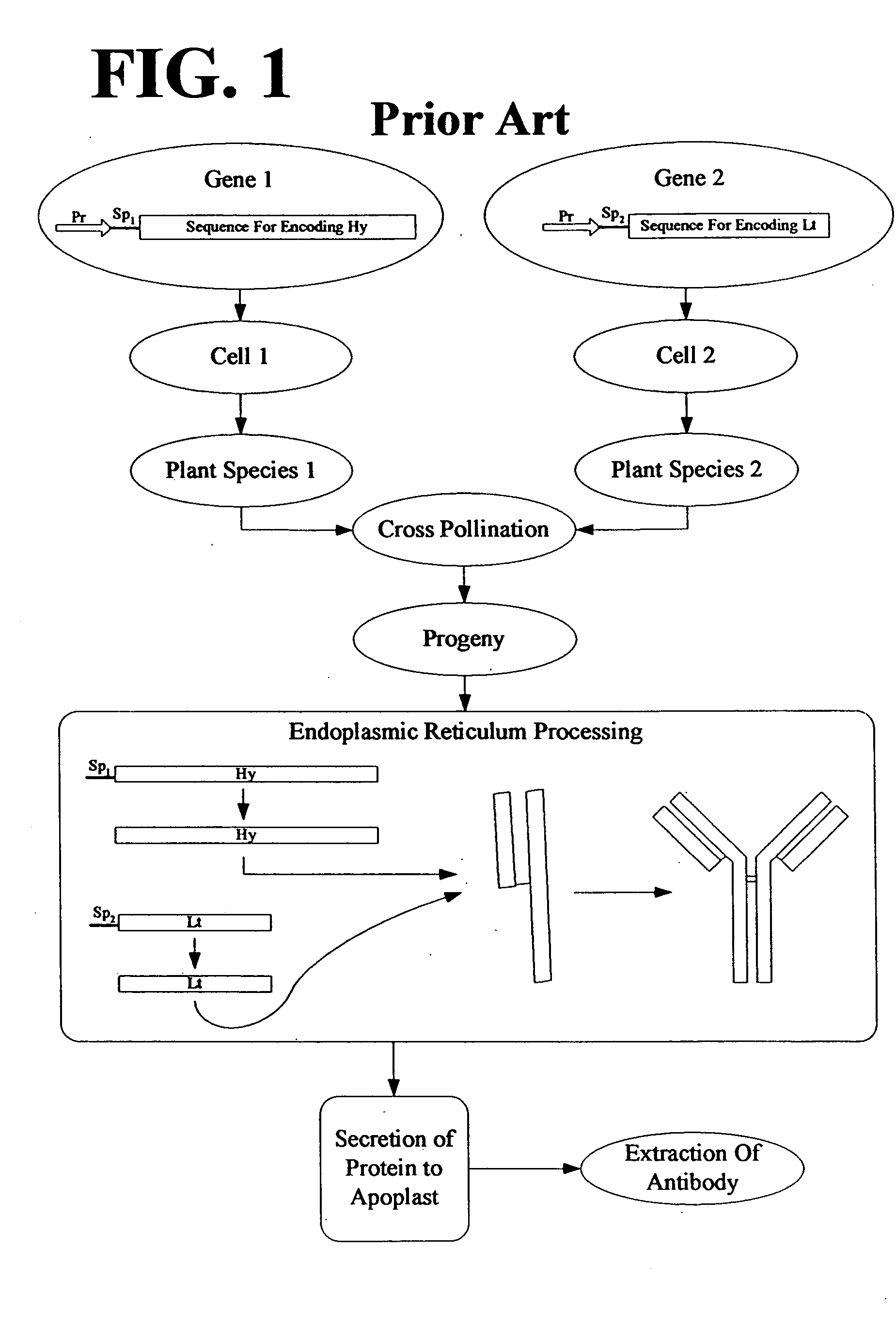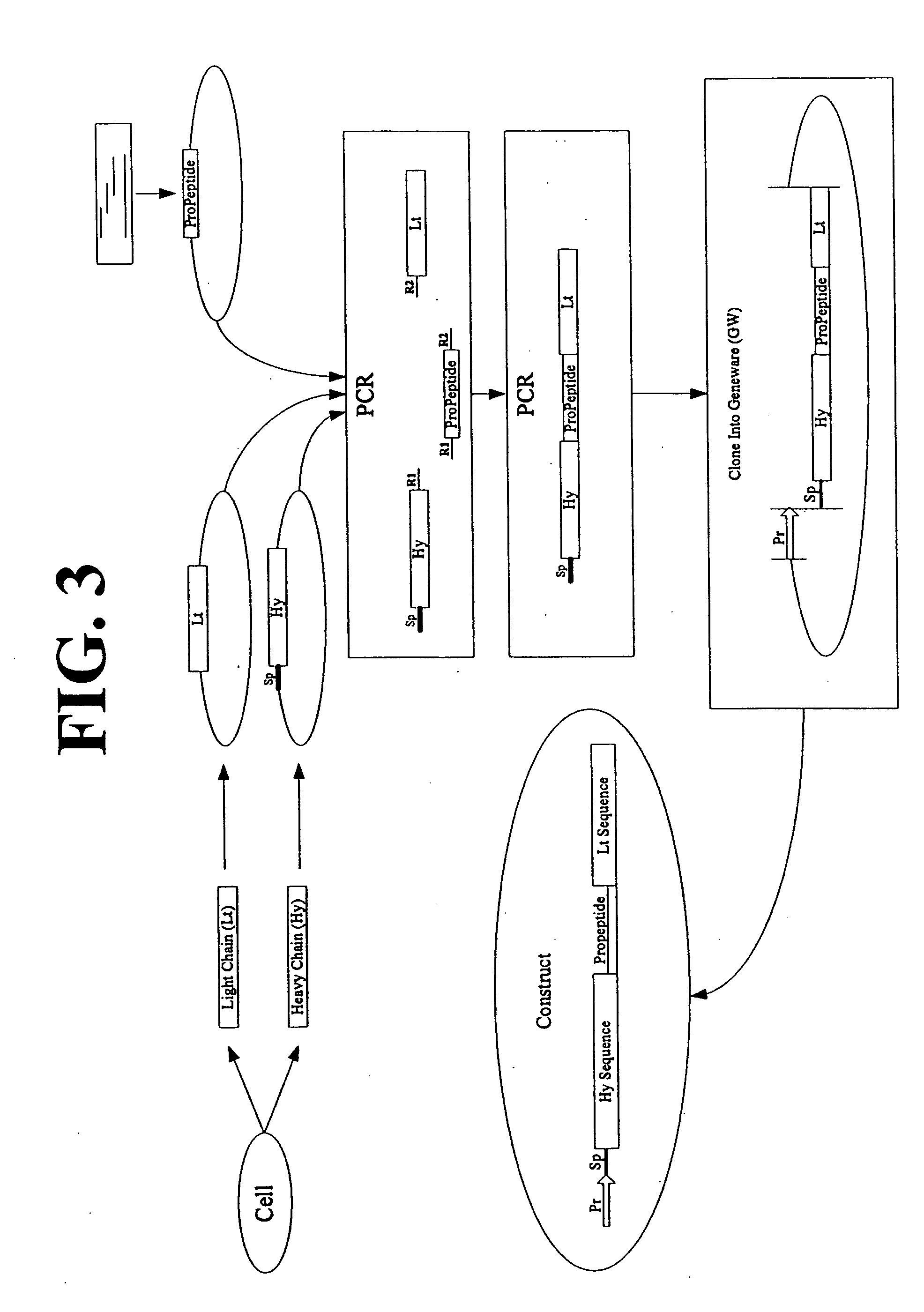Multimeric protein engineering
a multimeric protein and protein technology, applied in the field of multimeric protein engineering, can solve the problems of incomplete or delayed maturation of antibodies, aberrant accumulation of recombinant antibodies in foreign systems, complex process of b-cell maturation, etc., and achieve the effect of simplifying the production of multimeric proteins
- Summary
- Abstract
- Description
- Claims
- Application Information
AI Technical Summary
Benefits of technology
Problems solved by technology
Method used
Image
Examples
example 1
Cloning of the UmV KP6 Propeptide
[0245] The UmV KP6 propeptide region containing amino acids 106-138 was codon optimized for viral expression and assembled using overlapping synthetic oligonucleotides. Three overlapping oligonucleotides, one upstream, KP6-5′ (Seq ID No: 33), and two downstream, KP6-c3′ (Seq ID No: 34) and Kp6-3′ (Seq ID No: 35), were designed to have adenosine or thymidine preferentially in the third or wobble position for each triplet codon. A 100 μL PCR reaction containing 0.2 μM KP6-5′, 0.2 μM KP6-c3′, 0.2 μM Kp6-3′, 1× Cloned Pfu Buffer, 0.1 mM dATP, 0.1 mM dCTP, 0.1 mM dGTP, 0.1 mM dTTP, 1.25 Units Cloned Pfu Polymerase enzyme. The PCR reaction was amplified at 94° C. for 30 seconds, 25 cycles of 94° C. for 10 seconds, 48° C. for 15 seconds, 72° C. for 15 seconds, and 7 minutes at 72° C. The product from the above reaction was subsequently amplified with flanking primers which incorporates the coding sequence of a diglycine spacer at the 5′ end and KP6 toxin a...
example 2
Cloning of the Human Fab Preproprotein Library and Expression Analysis
[0246] Messenger RNA (mRNA) enriched for sequences containing long poly A tracts was isolated from total human spleen RNA (Clontech, Palo Alto, Calif.) using Dynabeads Oligo (dT)25 (Dynal, Oslo, Norway). The RNA was pelleted by centrifugation at 15 K rpm, 4° C. for 15 minutes, the supernatant removed and 1 mL of 70% ethanol added. The sample was centrifuged at 15 K rpm, 4° C. for 15 minutes, the supernatant removed and the pellet resuspended in 150 μL nuclease free water (Ambion, Austin, Tex.). 5 μg of the above prepared total RNA was incubated at 65° C. for 2 minutes, immediately placed on ice for 3 minutes, and then applied to 20 μL of magnetic beads in binding buffer (20 mM Tris-HCl (pH 7.5), 1.0 M LiCl, 2 mM EDTA) where the beads were prepared by washing with 50 μL of binding buffer. The RNA and bead mixture were incubated for 5 minutes with constant rotating. The supernatant containing unbound material was r...
example 3
Cloning of the 9E10 Heavy Chain and Light Chain Genes
[0252] Mouse hybridoma line Myc 1-9E10.2 expresses a murine monoclonal antibody (IgG1) that recognizes a human c-myc epitope of amino acid sequence EQKLISEEDL (G. I Evans et al., Molec. Cell. Biol. 5: 3610-3616, 1985). Cells were obtained from ATCC (CRL-1729) and cultured under standard conditions. 2×106 cultured cells were spun and washed to remove excess culture media and lysed with 600 μL RLT buffer containing 1% 2-mercaptoethanol (Qiagen, Valencia, Calif.). Total RNA was purified using the QIAshredder and RNEASY column per manufacturers directions. Briefly, the cell lysate was applied to the QIAshredder column and spun in a centrifuge for 2 minutes at 14K rpm. The flow through was collected and diluted with an equal volume of 70% ethanol. The mixture was transferred to a RNeasy column and centrifuged for 15 seconds at 10K rpm until all sample was processed through the column. The RNA bound to the column was washed with 700 μL...
PUM
| Property | Measurement | Unit |
|---|---|---|
| pH | aaaaa | aaaaa |
| pH | aaaaa | aaaaa |
| pH | aaaaa | aaaaa |
Abstract
Description
Claims
Application Information
 Login to View More
Login to View More - R&D
- Intellectual Property
- Life Sciences
- Materials
- Tech Scout
- Unparalleled Data Quality
- Higher Quality Content
- 60% Fewer Hallucinations
Browse by: Latest US Patents, China's latest patents, Technical Efficacy Thesaurus, Application Domain, Technology Topic, Popular Technical Reports.
© 2025 PatSnap. All rights reserved.Legal|Privacy policy|Modern Slavery Act Transparency Statement|Sitemap|About US| Contact US: help@patsnap.com



